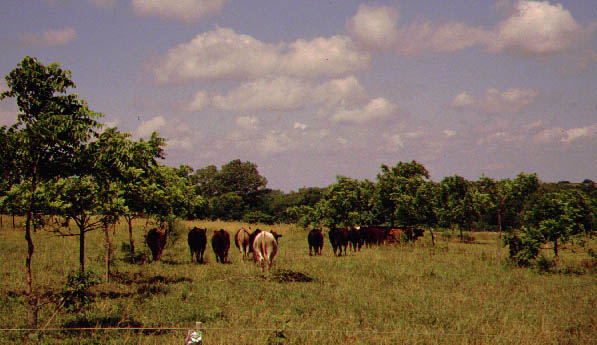It is generally accepted that cattle damage trees. But do cattle damage trees under plantation conditions when the grazing is tightly controlled? That's the question Larry Harper set out to answer on Harper-Hill Farms near Butler, Mo.
At a recent field day, Harper showed visitors preliminary results of grazing 26 head of steers in a black walnut plantation. The demonstration is part of a SARE grant project in cooperation with the University of Missouri Center for Agroforestry. The primary purpose of the demonstration/research project is to determine the amount and type of damage cattle may inflict on trees in an agroforestry system.
In the first year of the grazing trial, the 26 head of steers were placed in the plantation on April 22, weighing 575 pounds. The grass growing in the alleys between the 40-foot tree rows is mostly brome with some fescue creeping in and lespedeza and other legumes seeded for summer grazing. The trees are 20 feet apart within the rows. Most all trees have been grafted to known nut-producing varieties. The grafting process has created a wide range of tree heights from 2 feet to 17 feet throughout the plantation. Prior to grazing, all trees were measured for height and diameter.
Under the agroforestry system used at HarperHill, the steers are rotated through a series of 15 paddocks measuring slightly more than an acre each. The steers were moved every day so they had the freshest, most nutritious forage in front of them at all times. One of the questions to be addressed by the trial was to see if cattle would browse the trees under such controlled grazing conditions.
The simple answer is: "Yes, cattle do browse trees even when presented with the best forage possible."
It is noted that the steers established a browse line on the taller trees at about the 6-foot height. Trees shorter than 6 feet were severely damaged from both browsing and rubbing.
How tall must a walnut tree be before rubbing and browsing damage would be termed acceptable? From this first year trial it appears that a tree that is 10 feet tall or more is not adversely affected. The reason is that limbs would be pruned to the 6-foot level on this tree height anyway. Rubbing on the taller trees was minimal, perhaps because the shorter trees were more attractive as head and neck scratchers.
However, Harper says smaller trees, including new plantings of seedlings, can be protected from the cattle. Simply stringing an electric poly wire down each side of the tree row about 3 feet from the trees will discourage browsing. Trials at the Horticulture and Agroforestry Research Center at New Franklin, Mo. and at the Missouri Department of Conservation's Seat Farm in north Missouri have proven this method. Cost of the poly wire and temporary posts is not prohibitive, especially when you figure at least a 7-year life for the fencing materials. It comes out to $10 to $15 an acre depending on the width of tree rows.
The payoff from this system is in the early cash flow. If plantations can be grazed immediately after planting, the return on investment over the lifetime of the plantation is greatly increased because of the income during the early years. The steers in the HarperHill trial gained 1.5 pounds per day over a 90-day period.
A secondary payoff comes with reduced mowing especially for nut-producing plantations. Each mowing costs from $7 to $10 per acre.
Measurements for effects of trampling and compaction will be taken this fall, and the experiment will be repeated next year. Harper believes that one effect of the grazing will be even better forage because of stimulation of hoof action.
